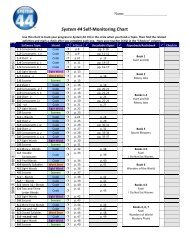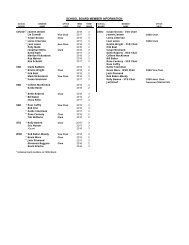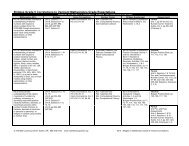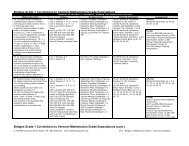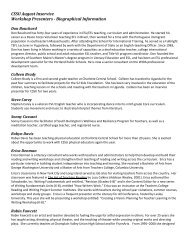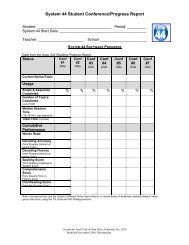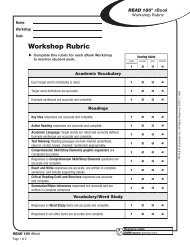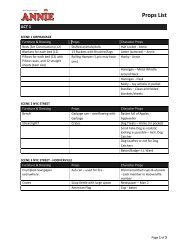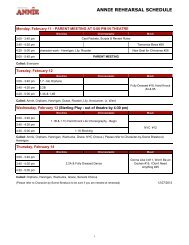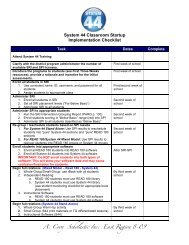You also want an ePaper? Increase the reach of your titles
YUMPU automatically turns print PDFs into web optimized ePapers that Google loves.
<strong>Applications</strong><br />
1. Ben claims that 12 is a factor of 24. How can you check to determine<br />
whether he is correct?<br />
2. What factor is paired with 6 to give 24?<br />
3. What factor is paired with 5 to give 45?<br />
4. What factor is paired with 3 to give 24?<br />
5. What factor is paired with 6 to give 54?<br />
6. How would you test to see whether 7 is a factor of 291?<br />
7. Multiple Choice Which of these numbers has the most factors?<br />
A. 6 B. 17 C. 25 D. 36<br />
8. Lareina understands factors, but sometimes she has trouble finding<br />
all the factors of a number. What advice would you give to help her<br />
find all the factors of a number? Demonstrate by finding all the<br />
factors of 110.<br />
9. Find two numbers that have 2, 3, and 5 as factors. What other factors<br />
do the two numbers have in common?<br />
10. a. What do you get when you use your calculator to divide 84 by 14?<br />
What does this tell you about 14 and 84?<br />
b. What do you get when you use your calculator to divide 84 by 15?<br />
What does this tell you about 15 and 84?<br />
11. Ramona says the Factor Game might also be called the Divisor<br />
Game. Do you agree? Why or why not?<br />
14 Prime Time
12. a. Is 6 a divisor of 18? Why or why not?<br />
b. Is 18 a divisor of 6? Why or why not?<br />
13. Which of these numbers are divisors of 64?<br />
2 6 8 12 16<br />
14. In Exercise 13, Evan noticed that some of the proper<br />
factors of 64 can be multiplied to get another proper factor<br />
of 64. For example, 2 and 8 are factors of 64, and 16 is also<br />
a factor of 64. Does every number have some factors for<br />
which this is true?<br />
For: Help with Exercise 14<br />
Web Code: ame-1114<br />
15. a. A prime number has exactly two factors, 1 and itself. If you circle<br />
a prime number in the Factor Game, your opponent will receive<br />
at most one point. Explain why. Give some examples.<br />
b. A composite number has more than two factors. If you circle a<br />
composite number in the Factor Game, your opponent might<br />
receive more points than you. Explain why. Give some examples.<br />
16. Why is the set of factors of a number not the same as the set of proper<br />
factors of that number?<br />
17. Using the terms factor, divisor, multiple, product, and divisible by, write<br />
as many statements as you can about the number sentence 4 3 7 = 28.<br />
18. Dewayne and Todd are playing the<br />
Product Game. Dewayne’s markers are<br />
on 16, 18, and 28, and Todd’s markers<br />
are on 14, 21, and 30. The paper clips are<br />
on 5 and 6. It is Dewayne’s turn to move<br />
a paper clip.<br />
1<br />
7<br />
The Product Game<br />
2<br />
8<br />
3<br />
9<br />
4<br />
10<br />
5<br />
12<br />
6<br />
14<br />
a. List the moves Dewayne can make.<br />
b. Which move(s) would give Dewayne<br />
three markers in a row?<br />
c. Which move(s) would allow him to<br />
block Todd?<br />
d. Which move do you think Dewayne<br />
should make? Explain.<br />
15<br />
25<br />
36<br />
54<br />
16<br />
27<br />
40<br />
56<br />
18<br />
28<br />
42<br />
63<br />
20<br />
30<br />
45<br />
64<br />
21<br />
32<br />
48<br />
72<br />
24<br />
35<br />
49<br />
81<br />
Factors:<br />
1 2 3 4 5 6 7 8 9<br />
Investigation 1 Factors and Products 15
19. a. Suppose that one paper clip on the Product Game board is on 3.<br />
What products can you make by moving the other paper clip?<br />
b. List five multiples of 3 that are not on the game board.<br />
c. How many multiples of 3 are there?<br />
20. Davis just marked 18 on the Product Game board. On which<br />
factors might the paper clips be placed? List all the possibilities.<br />
21. Find two products on the Product Game board, other than 18,<br />
that can be made in more than one way. List all the pairs of<br />
factors that give each product.<br />
22. Multiple Choice Which set represents all the factors of 12?<br />
F. {1, 2, 3, 4, 6, 12} G. {12, 24, 36, 48, c}<br />
H. {0, 1, 2, 3, 4, 6, 12} J. {1, 2, 3, 4, 6}<br />
23. Use the ideas from this investigation to list at least five facts<br />
about the number 30.<br />
24. Determine whether each of the following numbers can be made<br />
in more than one way in the Product Game. State whether the<br />
number is prime or composite.<br />
a. 36 b. 5 c. 7 d. 9<br />
25. Salvador said that the Product Game might also be called the Multiple<br />
Game. Do you agree? Why or why not?<br />
26. On the Product Game board, which number is both a prime number<br />
and an even number?<br />
27. Jose says the Factor Game and the Product Game are similar because<br />
both involve multiplication. Marcus says they are not similar. With<br />
whom do you agree and why?<br />
Connections<br />
28. Twenty-five classes from Martin Luther King Elementary School will<br />
play the Factor Game at their math carnival. Each class has<br />
32 students. How many game boards are needed if each pair of<br />
students is to play the game once?<br />
16 Prime Time
29. As part of the carnival, the school will hold a Factor Game marathon.<br />
It takes Archie and Kel an average of 12 minutes to finish one game.<br />
About how many games will they finish if they play nonstop from<br />
9:00 A.M. to 2:30 P.M.?<br />
30. Multiple Choice This week Carlos read a book for language arts class.<br />
He finished the book on Friday. On Monday he read 27 pages; on<br />
Tuesday he read 31 pages; and on Wednesday he read 28 pages. On<br />
Thursday and Friday he read the same number of pages each day. The<br />
book had 144 pages. How many pages did he read on Thursday?<br />
A. 28 B. 29 C. 31 D. 58<br />
31. Write a problem like Exercise 30 about a book you have read recently.<br />
32. Long ago, people observed the sun’s rising and setting over and over at<br />
about equal intervals. They decided to use the amount of time between<br />
two sunrises as the length of a day. They divided the day into 24 hours.<br />
Use what you know about factors to answer these questions:<br />
a. Why is 24 a more convenient choice for the number of hours in a<br />
day than 23 or 25?<br />
b. If you could select a number different from 24 to represent the<br />
number of hours in a day, what number would you choose? Why?<br />
Investigation 1 Factors and Products 17
33. a. In developing the ways in which we calculate time, astronomers<br />
divided an hour into 60 minutes. Why is 60 a good choice (better<br />
than 59 or 61)?<br />
b. If you could select another number to represent the number of<br />
minutes in an hour, what would be a good choice? Why?<br />
34. a. Is 132 divisible by 12? By 3? By 4?<br />
b. Is 160 divisible by 10? By 2? By 5?<br />
c. Is 42 divisible by 6? By 3? By 2?<br />
d. What patterns do you see in parts (a), (b), and (c)?<br />
For: Multiple-Choice Skills<br />
Practice<br />
Web Code: ama-1154<br />
For Exercises 35–37, find two numbers that can be multiplied to give<br />
each product. Do not use 1 as one of the numbers.<br />
35. 84 36. 145 37. 300<br />
38. a. Ms. Diaz wants to divide her class of 30 students into 10 groups,<br />
not necessarily of equal size. What are some of her choices?<br />
b. Ms. Diaz wants to divide her class of 30 students into equal-sized<br />
groups. What are her choices?<br />
c. How is the thinking you did in part (a) different from the thinking<br />
you did in part (b)?<br />
Extensions<br />
39. Jocelyn and Moesha decide to play the Factor Game on a 100-board,<br />
which includes the whole numbers from 1 to 100.<br />
a. What will Jocelyn’s score be if Moesha chooses 100 as her first<br />
move?<br />
b. What will Jocelyn’s score be if Moesha chooses 99 as her first move?<br />
c. What is the best first move on a 100-board?<br />
40. What is my number?<br />
Clue 1 When you divide my number by 5, the remainder is 4.<br />
Clue 2<br />
My number has two digits, and both digits are even.<br />
Clue 3 The sum of the digits is 10.<br />
18 Prime Time
41. The Factor Game can be played on a 49-board, which includes the<br />
whole numbers from 1 to 49.<br />
a. Use your table for analyzing first moves on a 30-board from<br />
Problem 1.2. Extend it to include all the numbers on a 49-board.<br />
b. What new primes do you find?<br />
The Factor Game<br />
1<br />
2<br />
3<br />
4<br />
5<br />
6<br />
7<br />
8<br />
9<br />
10<br />
11<br />
12<br />
13<br />
14<br />
15<br />
16<br />
17<br />
18<br />
19<br />
20<br />
21<br />
22<br />
23<br />
24<br />
25<br />
26<br />
27<br />
28<br />
29<br />
30<br />
31<br />
32<br />
33<br />
34<br />
35<br />
36<br />
37<br />
38<br />
39<br />
40<br />
41<br />
42<br />
43<br />
44<br />
45<br />
46<br />
47<br />
48<br />
49<br />
42. Lana and Luis are playing the Factor Game on a 49-board. Lana has<br />
the first move and chooses 49.<br />
a. How many points does Luis score for this round?<br />
b. How many points does Lana score for this round?<br />
43. What is the best first move on a 49-board? Why?<br />
44. What is the worst first move on a 49-board? Why?<br />
45. What three factors were used to make<br />
this Product Game board? What product<br />
is missing from the grid?<br />
4<br />
14<br />
6<br />
?<br />
9<br />
49<br />
Factors:<br />
46. What four factors were used to make<br />
this Product Game board? What product<br />
is missing from the grid?<br />
9<br />
21<br />
15<br />
?<br />
36<br />
18<br />
30<br />
42<br />
35<br />
49<br />
Factors:<br />
Investigation 1 Factors and Products 19
47. The sum of the proper factors of a number may be greater than, less<br />
than, or equal to the number. Ancient mathematicians used this idea to<br />
classify numbers as abundant, deficient, and perfect. Each whole<br />
number greater than 1 falls into one of these three categories.<br />
a. Draw and label three circles as shown below. The numbers 12, 15,<br />
and 6 have been placed in the appropriate circles. Use your factor<br />
table to determine what each label means. Then, write each whole<br />
number from 2 to 30 in the correct circle.<br />
12<br />
Abundant<br />
15<br />
Deficient<br />
6<br />
Perfect<br />
b. Do the labels seem appropriate? Why or why not?<br />
c. In which circle would 36 belong?<br />
d. In which circle would 55 belong?<br />
48. Look at the Product Game board you used in Problem 1.3. Which of<br />
the numbers on that board can be formed by placing both paper clips<br />
on the same number? These numbers are called square numbers.Why<br />
do you think they have this name?<br />
49. a. Suppose you choose 16 as a first move in the Factor Game. How<br />
many points does your opponent get? How does your opponent’s<br />
score for this turn compare to yours?<br />
b. Suppose you choose 4 as a first move. How many points does your<br />
opponent get? How does your opponent’s score for this turn<br />
compare to yours?<br />
c. Find some other numbers that have the same pattern of scoring as<br />
4 and 16. These numbers could be called near-perfect numbers.Why<br />
do you think this name fits?<br />
Is there a largest perfect number? Mathematicians have been trying<br />
for hundreds of years to find the answer to this question. You might<br />
like to know that the next largest perfect number after 6 and 28 is 496.<br />
For: Information about<br />
perfect numbers<br />
Web Code: ame-9031<br />
20 Prime Time



